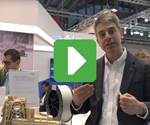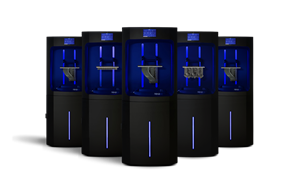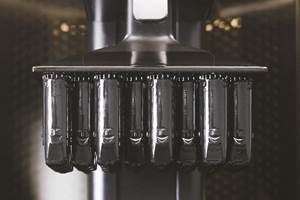Video: Support Structures Are Misnamed! How to Understand Anchors in Additive Manufacturing
Supports or anchors can account for a significant share of both the engineering investment and material use in metal additive manufacturing. Michael Hansen of SLM Solutions discusses the role and importance of support structures.
Share
Read Next
A major component of metal additive manufacturing (AM) via selective laser melting is support structures. This element of the metal additive build gets thrown away, but it is vital to the success of the build and can account for a significant share of both the engineering investment and material use. Michael Hansen of SLM Solutions says support structures are underappreciated, and the lack of understanding begins with the name. They should more accurately be called “anchors,” he says. Above is our conversation about the role and design of these supports or anchors. Skip to transcript.
What is the purpose of support structures?
- Support overhung sections
- Anchor the part to the build plate
- Remove heat from the part
Support overhung sections. A common assumption is that support structures simply hold up overhangs that risk falling down while on the build plate. That is one use, but they do much more.
Anchor the part to the build plate. Powder bed fusion is a welding process with considerable inherent stress that can lead to deformation. Support structures serve as an anchor that holds the part in place for the duration of the build.
Remove heat from the part. Support structures can function as a thermal sink, pulling heat away from the part. This can prevent heat consolidation that causes warpage, delamination or deformation during the build, which can ultimately damage a part.
How are support structures removed?
- By hand in some cases — see the small, breakable pins that attach the part to the support structures at 5:34 in the video above
- With a bandsaw
- With EDM (electrical discharge machining) when a more precise cut is needed
Transcript
Peter Zelinski, Additive Manufacturing
Potentially a significant part of the engineering, the material use and the success of a metal additive build is the support. Someone who thinks a lot about this is Michael Hansen of SLM Solutions.
Michael, a reality of metal additive manufacturing is support structures, what our support structures doing, what purpose or purposes do they play?
Michael Hanson, SLM Solutions
One of the things I'd like to dispel is, support structures is a bad term in general. They would be better off [being] called anchors. They help get the heat away from the part and help to prevent the part from delaminating or deforming during the build. Powder-bed fusion is a welding process, so there's a lot of inherent stress, so we need to hold the part in place for the duration of the build.
Peter Zelinski
We are using a somewhat incorrect term "support structure" because we have the picture that somehow there are overhangs and [that] parts of the part geometry are going to fall down. Perhaps to some extent that's legitimate, but you're describing that the larger role the support structures play, the anchors play, is to keep [and] to help maintain the shape of the part against its own internal stresses. So these supports, these anchors, are ultimately scrap material. And they have to be removed to finish the part. Describe how the anchors are typically removed.
Michael Hanson
The state of that process right now ... there are many companies working on an automated process for moving supports. But the current state is these would be either, cut off the plate with a band saw, or an EDM for higher precision. But generally, you're going to have somebody there breaking the supports off by hand.
Peter Zelinski
How significant can supports be in terms of the volume of the build, the cost of material used? Am I correct in saying a significant amount of the material you put into the build is for supports?
Michael Hanson
Absolutely. In the case of these parts, these have a fair amount of support, but they've been optimized to have, you know, not much support in certain locations. But things that are traditionally manufactured and they're moving towards additive often require more supports to hold them to the build plate.
These are porous, and they allow powder to be evacuated from them. It might be that I might model up a cube or something else sacrificial and consume a fair amount of powder. But there's a tradeoff, because if that allows me to cut the part off located in a machining center, and then remove it, it's just easier and a more automated process.
Peter Zelinski
You've just alluded to another significant investment. It could be that there's a considerable amount of design work, engineering work that goes into thinking about the optimal form of the supports.
Michael Hanson
It's really a sliding scale. If I have somebody that I can pay $10 an hour to venture a part for 10 hours, it might make financial or fiscal sense to do that. But if I'm going to make 5,000 of these, it makes sense to engineer in my support and my workholding, so I can remove it from the build plate, load it into my machine tool and maybe do some finishing operations.
Peter Zelinski
Can you talk a little bit more about the tradeoffs in terms of the geometry of the supports?
Michael Hanson
Many of the supports are going to have to support certain areas of the part to try to get heat away. One of the examples I'll use from a customer. They were doing some titanium arms kind of similar to this and they had removed all of the support except for a couple of areas because they wanted to sustain that material. They had to go back [and] add more supports to it so that they could get the heat out of the part and not have that heat consolidation, which, in the end, was warping the part more and causing damage to the part.
Peter Zelinski
They put more into the support because of the heat. That points to a purpose of supports that maybe we haven't mentioned yet, but it's a thermal sink also, isn't it?
Michael Hanson
Correct. Yeah. So, one of the major issues, especially in this proprietary sport, we just developed with additive designer, it serves three functions. It uses a unit cell that increases and decreases in size, basically to use less material, aid in thermal evacuation of heat and then also aid in the part removal. There are small pins at the interface between the support in the part, in which case I can actually kind of peel that part off, and is much easier to remove.
Peter Zelinski
What is additive designer?
Michael Hanson
SLM Solutions partnered with a company in Austria called CADS and we started the SLM Software Group. Additive Designer is the first product release for preparation of files. The core competence of that software is locating the part, orienting the part and also creating supports and then doing slice files.
Peter Zelinski
I'm seeing some geometric effects within the supports here. This tall one is porous for the sake of powder removal. These shorter ones have geometric features, openings in them that look to me like maybe they're conserving the amount of material that you use?
Michael Hanson
The taller supports are referred to generally as a block support, and it's a standard style of support, often we will perforate it and add holes to help and aid in the powder removal. The other ones are called heart cell, and that's a proprietary support in Additive Designer that we've created to, again, help with less material consumption for waste, help to get the heat out of the part, and then also, again, for ease of part removal.
Peter Zelinski
Ease of part removal. I'm seeing these very small pins that must connect to the part with a very small amount of force and this is broken away by hand. Is there a hand finishing process right after that?
Michael Hanson
Yeah, so you can hand finish it or, depending on the workholding, you could flip it over and face mill it or do some other machining operation. But the nice thing about having the small interfaces with the pins is if you get into steels and Inconels, you crush that with some pliers or something else to try to remove it, and it becomes this mass and then it becomes very cumbersome to remove. By having the small pin interface, it kind of eliminates that and it actually breaks away much easier.
Peter Zelinski
Am I looking at an orientation of this form, for example, that's optimized to minimize the amount of support needed?
Michael Hanson
That's a great point. If I wanted to really minimize this build time, I could probably take one of these and bring it down very close to the plate. But what I sacrifice there is I might have to add more support, and then there's more postprocessing on the back end.
Some people really need to get speed out. I have a dental customer that, you know, they run two build plates a day. They try to cram as many parts on that plate that they can so it finishes within nine hours, which is their shift time. They could effectively probably double the amount of parts that they could produce by standing them up more vertically, but it doesn't fit within the model. It makes sense to have it constrained within that build time.
Peter Zelinski
Are there any geometries that are precluded from selective laser melting, because there would need to be supports or anchors?
Michael Hanson
As you look at a 10 millimeter hole, they're going to start to get teardrop shaping and some other things that either can put support in there, or you deal with the deformation that comes along with it. There have been advances, again, in Additive Designer, we re-did the slice file so that we have greater control over that. The limiting factor now is a 25-degree angle instead of somewhere near 45. That's what's publicized. We've [found] in our tests, even titanium parts, they will close the gap. The surface finish is going to degrade a little bit more, but we get good surface finish at 20 degrees. So we're going to continue to work and refine those scan paths so that we can remove as much support as possible.
Peter Zelinski
If the supports are poorly designed, what are some of the dangers?
Michael Hanson
One thing is overbuilding supports and one is under[building], right, and they're going to fail catastrophically for different reasons. Overbuilding supports might mean that I have some mesh density that's too tight and, as I'm scanning it, because the power using supports is different than the rest of the scanning strategies, it might grow out of the powder bed and then therefore interfere with the recoater and then eventually catastrophically fail. On the opposite side of that if I underbuild my supports, I have a propensity for delamination where the part will peel. That's a much more catastrophic failure, when a large part crashes into the recoater.
Peter Zelinski
Is there ever a situation where you would want to specifically engineer to have supports that hold tighter, supports that are not so easy to remove? I'm thinking for the needs of downstream machining, for example. Is there ever a case where you'd want supports to be the workholding for a later process?
Michael Hanson
Yeah, absolutely. I can think of a situation where there might be a part that's quite thin on the bottom and have a lot of mass up top. I would need to add a lot of support to make sure that that piece is held very rigid in place, or I might need to do a complex porting option or something at the top.
The ask for many of our customers is, hey, I want the process to be completely automated. I don't want to have to rely on simulation to tell me what this is or I have to, you know, wait 10 hours to get a result on something on how to build a part, when in reality, I can probably build the part faster. Often we will tell them, hey, it's easier to just weld it to the plate and overbuild supports, so that you guarantee success in the build rather than going through the complete optimization, because the payoff is sooner, right? At the end of the day, I want a part out of the machine and if I can get that faster by having a less optimal solution, that's my goal.
Related Content
How to Build 10,000+ Shot Molds in Hours
Rapid tooling isn’t so rapid when it takes days to 3D print a metal mold, and then you still must machine it to reach the necessary tolerances. With Nexa3D’s polymer process you can print a mold in hours that is prototype or production ready and can last for more than 10,000 shots.
Read MoreAM 101: What Is Binder Jetting? (Includes Video)
Binder jetting requires no support structures, is accurate and repeatable, and is said to eliminate dimensional distortion problems common in some high-heat 3D technologies. Here is a look at how binder jetting works and its benefits for additive manufacturing.
Read MoreHow to Improve Polymer AM Productivity 20X
A fast cycle time is critical to efficient production 3D printing, but it’s not the only thing. How you choose the right parts for AM, prepare jobs for production, and manage post processing will have just as big an impact on total 3D printing throughput. It all needs to work together to achieve maximum productivity.
Read MoreAM 101: Digital Light Synthesis (DLS)
Digital Light Synthesis (DLS) is the name for Carbon's resin-based 3D printing process. How it works and how it differs from stereolithography.
Read MoreRead Next
Video: In Additive Manufacturing, Material Engineering Is Also Needed for Supports
The sacrificial material affects the quality of 3D printing and the efficiency of the process. That's why material developers direct attention toward the material that gets thrown away.
Read MoreAt General Atomics, Do Unmanned Aerial Systems Reveal the Future of Aircraft Manufacturing?
The maker of the Predator and SkyGuardian remote aircraft can implement additive manufacturing more rapidly and widely than the makers of other types of planes. The role of 3D printing in current and future UAS components hints at how far AM can go to save cost and time in aircraft production and design.
Read MoreHybrid Additive Manufacturing Machine Tools Continue to Make Gains (Includes Video)
The hybrid machine tool is an idea that continues to advance. Two important developments of recent years expand the possibilities for this platform.
Read More





















